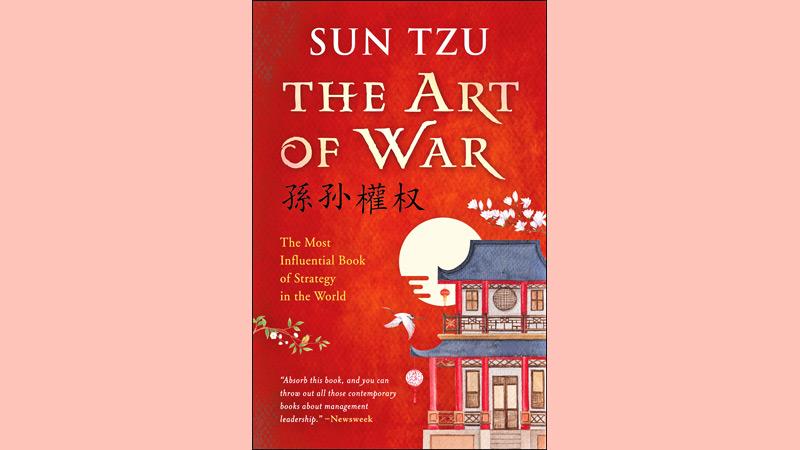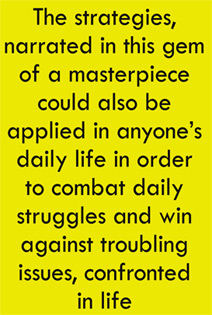
The other day, a chum of mine told me that he was obsessed by old books as he could learn from those who built civilizations from scratch than those who tore it down.
 I agree as a popular adage says that reading old books is just like a conversation with the finest minds of the past centuries.
I agree as a popular adage says that reading old books is just like a conversation with the finest minds of the past centuries.
“The Art of War”, as told by scholars, written by Sun Tzu, a legendary military strategist and a philosopher between 475 and 221 BCE during the Warring States period is one of the classic synonyms of an old book of which significance and relevance flows even to eternity.
Written rigidly and conscientiously, “The Art of War” is predominantly a timeless and ageless classic which is connoted for readers of every level.
Dr. Krishantha Kapugama, an academician and a military strategist remarks that history and culture of East Asia are depicted across eleven chapters of the “The Art of War”; it is invested with the affluence and lavishness of the traits of a celebrated timely classic that is teeming and copious in wisdom, advice, counselling, guidance and of thinking that is of the towering magnitude.
Dr Kapugama notes that the book is enriched with the aphorisms and axioms that make the reader ponder and wonder over the timeless wisdom with which our forefathers were blessed in an era where technology was still in its infancy level.
A sheer glance at the title of the book convinces and oscillates the prospective reader into an imagination of a battlefield circumstance. Dr. Kapugama argues that the book simply about the philosophy which is engulfed with fighting the enemy and the politics of warfare as well as that of the strategies that would pave the way for a triumphant military intervention in a facilitative manner.
Daily life
As highlighted by Dr. Kapugama, the strategies, narrated in this gem of a masterpiece could also be applied in anyone’s daily life in order to combat daily struggles and win against troubling issues, confronted in life.
“The Art of war” has got a biblical reputation. Arguably it contains far reaching classifications on as to how it could be dealt with the potential conflicts of our lives. “The greatest victory is that which requires no battle” is one of the most celebrated and ever treasured adages, included in “The Art of War” of which prominence is a durable life lesson that gives a tolerable endurance at a peace negotiating table, requiring a truce.
Dr. Kapugama claims that some people blindly believe that anger is a virtue that brings power and wealth where the very same thought itself drives them into utter chaos and destruction.
While recalling his memory on one of the most cherished adages on “The Art of War” which is “Who wishes to fight must first count the cost”, Dr. Kapugama moreover notes that the power of such words potentially promotes an enormous degree of goodwill even among those who are at a battle where they can always be requested to come to the negotiating table.
A narrative of such calibre in retrospect would suggest a prospective reader to reside in the classifications of a stanza in the Dhammapada, preaching by the Enlightened One where it is said that hatred never ceases by hatred, instead hatred can be conquered by loving kindness while the same demonstrates close links with the plot of “A Long Walk to Freedom”, biography of Nelson Mandela whose policy of forgiveness and reconciliation ended the dark period of apartheid in South Africa.
Approach
Dr. Kapugama says, “The book asks you to rethink and reconsider your approach to the most critical and crucial events and breakthroughs in your life, your work, your existence as well as that of your personal development.
The text very well convinces you of that there is such a lot to learn and much to re-purpose”.It is absolutely with this specific pragmatic and constructive outlook that fighting for life as a wholestands as a way of an art which the great philosopher lived within Sun Tzu helps his readers across the galaxy to master, propagate and promote by means of the priceless and rare adages, running across his text.
Meanwhile, Dr. Kapugama finds that the text contains more reasoning and rational tactics and strategic methods which are able to enhance the reader’s comprehension on the war’s backstage circumstances.
Dr. Kapugama remarks that the book has already been predominantly read across the world while it is also evident that even right at this moment itself, it is being read in any part of the planet where still it enjoys an almost unparalleled popularity equally among the war veterans and the ordinary folk.
The text significantly covers almost every phenomenon of war, notably various areas in a war zone. Dr Kapugama declares that this includes the utter most significance of positioning the warriors as well as the combatants at war as a part of a military strategy which is employed in order to fool the spies and the opponent warriors undercover to the conduct which is expected from the warriors as well as the counter treatment of the troopers with the intention of employing a fool proof dynamic strategy which would eventually pave the way for an explicit and precise triumph and conquest.
Fine lesson
The point at issue of the text is undoubtedly not to stage war against another state but to nip an impending provocative circumstance in its bud and also to make certain that a war of any magnitude could be circumvented by means of peaceful negotiations.
The abrupt terse and the concise epigrammatic that is found in the text is paramount and relevant even to the readers of the present-day world context.
Dr. Kapugama opines that the text is a fine lesson that teaches you of the ways and means of controlling your temper, anger and fear; it makes you aware of arousing peace and harmony within yourself. You may add “The Art of War”into your booklist. It is simply a toolkit for an entrepreneur whose business could thrive among the pages of ‘The Art of War’. It is an interesting and informative epic of all time that an enthusiastic reader should not miss to have in his bookshelf.
